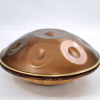
Tuning of Guda Drum by Zen Percussion. Most popular scales and advices for fine-tuning.
- The tone range for Guda 2.0 Standard: F3 to C5
- The tone range for Guda 2.0 Plus and Guda Double: from D3 to E5
- Guda Ortus Brass: from D3 to D5
- Guda Ortus Ultra: from D2 to D5
- Guda Coin Brass: from D3 to B5
- Guda Coin Ultra: from G2 to B5
- The tone range for Guda Neo 9 from Eb3 to E5
- The tone range for Guda Freezbee: from A3 to E5
More info about tone range and scales you can find in these 2 articles:
Taking into account the physical characteristics of each model, we have transposed all of our most popular scales for Guda 2.0, Neo and Freezbee models. The table with our most popular scales for all Guda drum models you can find here:
In some cases, we can tune the scale higher/lower to the required number of semitones. We also make custom scales on request, if they fit within the range of the selected model . When ordering of a custom scale you should also take into account the fact that steel tongue drums sound best when adjacent tongues have the interval of a whole tone or more. Scales which have many neighboring tongues with half tone intervals may sound unintelligible. In any case, all custom scales should be discussed with our manager before ordering.
Unlike handpans, steel tongue drums save their tuning for a much longer time. We use a very hard stainless steel to adjust our Guda tongue drums, so the instruments do not require additional tuning for many years with a neat game. However, sometimes it becomes necessary to fine-tune the drum. This can occur as a consequence of careless handling with a tool (for example, if the drum is dropped facedown, exposed to contact with fire, etc.). In this case, we can retune the drum or give you the advices on how to do it yourself.
We can retune your instruments for free, but all expenses for transportation are paid by the customer. If the tongue drum went out of tune slightly, you can manually adjust it. To do this, you need to get an electronic tuner (a computer with tuner program) and follow two rules:
- Before tuning, you have to isolate one tongue from others. You can use the adhesive tape and stick all tongues except one that should be tuned.
- If you need to make the sound of the tongue higher, you should gently pry it with a thin object (e.g. a knife blade or small screwdriver) and slightly bend outwards.
- If you need to lower the sound, you should carefully bend the tongue with your fingers inside (or take a small piece of wood, dense rubber or plastic) .
All operations should be carried out very carefully, the position of the tongue should change to fractions of a millimeter, otherwise you risk spoiling your instrument.
Some advices about Exploitation and Care of Guda Tongue Drum






